The Apple iPad Review (2012)
by Vivek Gowri & Anand Lal Shimpi on March 28, 2012 3:14 PM ESTA5X vs. Tegra 3 in the Real World
Even with the inclusion of GLBenchmark data, we're still arguing over theoretical advantages. Any 3D game developed for Android or iOS is going to target 30 or 60 fps and try its best to stay there. Similar to a console, on an Android or iOS tablet there's no disabling vsync and there's (almost) no tinkering with image quality settings to impact performance. The trick on Android is really ensuring that experience across all available SoCs, but if we cull the list down to the best of the best—chances are you'll have a good experience on both sides of the fence.
NVIDIA's Tegra 3 is at the heart of our current favorite in the Android tablet space: ASUS' Transformer Prime. There also happen to be some games that are available on both Android and iOS. Take Modern Combat 3, available on both iOS and Android—do we see the same ~2x performance advantage from Egypt in this title compared to ASUS' TF Prime?
NVIDIA makes two counter arguments against Apple's claim that the A5X delivers superior gaming performance. The first is that despite any theoretical performance advantages the A5X may hold, they don't manifest in games today. The second NVIDIA argument is that via Tegra Zone, Android titles can look better than their iOS counterpart. Both of these are potentially valid claims, but let's test them.
Shadowgun is an NVIDIA favorite. It's a first person shooter that's available via NVIDIA's Tegra Zone app. The Tegra specific version offers support for gamepads and stereoscopic 3D with enhanced graphics specifically for Tegra 2 and Tegra 3. It works for our little experiment here because it's also available on iOS.
Shadowgun also ends up being a great example of what the Android/iOS divide looks like for many Tegra Zone games. This particular title appears to still render at 1024 x 768 on the new iPad, we simply get an upscaled image rather than a higher resolution. In turn it means we get more aliasing and a less sharp image compared to what we get on ASUS' Transformer Prime, where the game runs at 1280 x 800.
Apple's A5X delivers an extremely smooth frame rate in Shadowgun. Although there's no built in timedemo, frame counter or benchmark functionality, the game runs subjectively smoother on iOS compared to on the TF Prime running Ice Cream Sandwich. Although the frame rate is higher on the iPad, I wouldn't consider it unacceptably low on the TF Prime—both are definitely playable.
Where the Tegra Zone version of the game has an advantage is in its visuals. The NVIDIA enhanced version uses higher resolution textures and features what appears to be CPU accelerated cloth physics in objects that simply don't exist in the iOS version. Some scenes also include other additional details (e.g. water on the floor) that aren't present in the iOS version. None of these additions fundamentally change the gameplay at all, but they do make for a better looking game.
Is it physically possible to have the same experience on iOS? Quite possibly. What we're seeing here is a mobile representation of what NVIDIA has done in the PC industry for years. By lending its support to smaller Android developers, their games are made prettier on NVIDIA hardware, and in turn NVIDIA helps promote those games via Tegra Zone and other channels. Obviously Apple could do the same, but thus far it hasn't needed to. Apple instead prefers giving its partners what someone very smart once referred to as most favored nation status. As a MFN, these game developers get additional exposure in the app store and elsewhere in Apple's promotions. It's very similar to what NVIDIA is doing, except on a much larger scale and without the iOS specific visual enhancements.
The comparison becomes even more complicated when you take into account the iPad's Retina Display looks better than the panel on the TF Prime. It's not really the higher resolution but rather the improved color reproduction on the iPad.
Riptide GP is another example of a Tegra Zone title available on both iOS and Android, although here the Tegra optimizations are less impressive while the Retina Display's advantages are more pronounced. There's no perceivable difference in frame rate here either, making it a much closer call:
Grand Theft Auto 3 was recently ported to both Android and iOS, and with this title we find ourselves in a unique position: the Android version offers customizable visual quality. The iPad version of the title renders at 1024 x 768 regardless of hardware generation and performance is understandably smooth. Visual quality is configurable, only on the Android version, with draw distance, screen resolution and effects quality vectors:
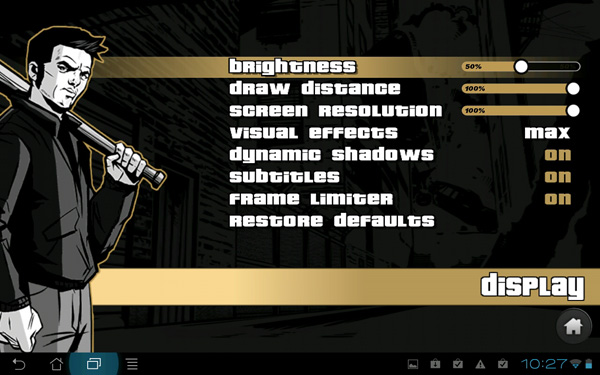
These sliders/options have different defaults depending on what SoC they are running on. The Transformer Prime is capable of running GTA3 at the highest quality settings with a tangible but livable drop in frame rate. The end result is a significantly better looking game on Android, although to be honest it's something that you really only notice if you are doing a side by side comparison. If all you have is an iPad or TF Prime, you'd likely just grow used to whatever platform you had.
The TF Prime experience doesn't map as well to other tablets unfortunately. While playing GTA 3 on a Xyboard 10.1 (OMAP 4430) even at its default settings of 50% draw distance, 60% resolution and low effects quality, there's unusual stuttering during gameplay. The frame rate is otherwise smooth, but the periods of stutter significantly impact the overall experience.
Unfortunately the Android vs. iOS gaming comparison isn't always this easy. While some apps won't run on older Apple hardware, there are only three generations of iPad to worry about. Furthermore, within a single generation there aren't multiple performance levels to worry about as Apple only offers a single SoC. By comparison, there's a far larger selection of Android devices. Simply having the latest and greatest hardware isn't a guarantee that you'll be able to play every game in the Google Play store. Take Modern Combat 3 for example. Modern Combat 3 is a Call of Duty clone available on both iOS and Android. The game won't install on an ASUS Transformer Prime or a Motorola Xyboard 10.1:
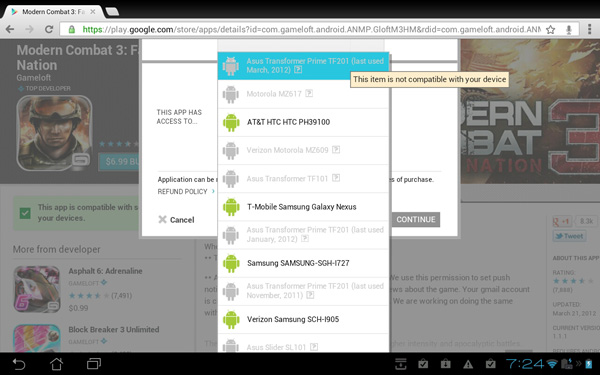
The Play store keeps track of all of the devices I've used with my Google account and the compatibility list doesn't look good. Obviously this isn't Google's fault directly as the responsibility falls upon the game developer to ensure broad platform compatibility, but it is a problem for anyone who purchases a flagship Android device like the Transformer Prime. Either Google has to enforce compatibility across all of its devices or it needs to at least force developers to support a single, flagship platform. Perhaps one reason I'm seeing this today is because there is no Nexus tablet yet. If that's the route Google is going to count on, the first iteration of any major platform needs to be a Nexus device. In other words, the Transformer Prime should have been a Nexus to begin with.


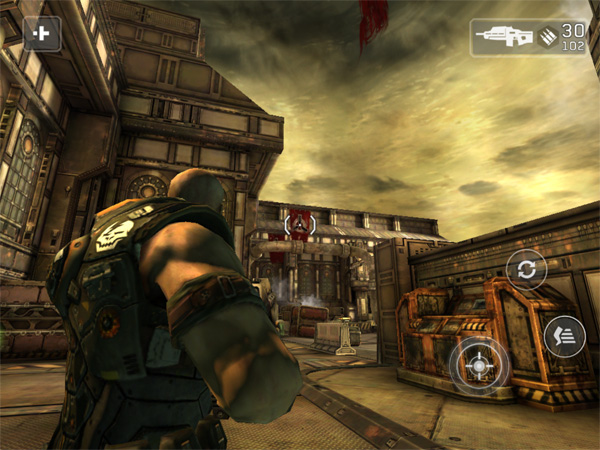







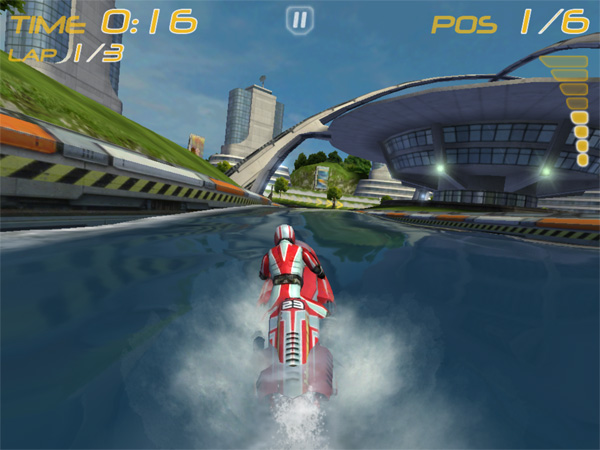
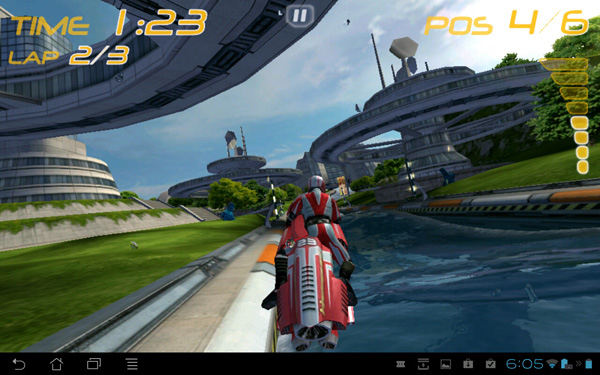
















234 Comments
View All Comments
name99 - Friday, March 30, 2012 - link
Just to clarify, this is NOT some Apple proprietary thing. The Apple ports are following the USB charging spec. This is an optional part of the spec, but any other manufacturer is also welcome to follow it --- if they care about the user experience.darkcrayon - Thursday, March 29, 2012 - link
All recent Macs (last 2-3 years) can supply additional power via their USB ports which is enough to charge an iPad that's turned on (though probably not if it's working very hard doing something). Most non-Mac computer USB ports can only deliver the standard amount of USB power, which is why you're seeing this.Your Lenovo *should* still recharge the iPad if the iPad is locked and sleeping, though it will do so very slowly.
dagamer34 - Friday, March 30, 2012 - link
I did the calculations and it would take about 21 hours to recharge an iPad 3 on a normal non-fast charging USB port from dead to 100%. Keep in mind, we're talking about a battery that's larger in capacity than the 11" MacBook Air.snoozemode - Thursday, March 29, 2012 - link
http://www.qualcomm.com/media/documents/files/snap...Aenean144 - Thursday, March 29, 2012 - link
Anandtech: "iPhoto is a very tangible example of where Apple could have benefitted from having four CPU cores on A5X"Is iPhoto really a kind of app that can actually take advantage of 2 cores? If there are batch image processing type functionality, certainly, though I don't know if iPhoto for iOS has this type of functionality. The slowness could just be from a 1.0 product and further tuning and refinement will fix it.
I'm typically highly skeptical of the generic "if the app is multithreaded, it can make use of all of the cores" line of thought. Basically all of the threads, save one, are typically just waiting on user input.
Anand Lal Shimpi - Thursday, March 29, 2012 - link
It very well could be that iOS iPhoto isn't well written, but in using the editing tools I can typically use 60 - 95% of the A5X's two hardware threads. Two more cores, at the bare minimum, would improve UI responsiveness as it gives the scheduler another, lightly scheduled core to target.Alternatively, a 50% increase in operating frequency and an improvement in IPC could result in the same net benefit.
Take care,
Anand
shompa - Friday, March 30, 2012 - link
*hint* Use top on a iOS/Android device and you will see 30-60 processes at all time. The single threaded, single program thinking is Windows specific and have been solved on Unix since late 1960. Todays Windows phones are all single threaded because windows kernel is not good at Multit hreding.With many processes running, it will always be beneficial to have additional cores. Apple have also solved it in OSX by adding Grand central dispatch in their development tools making multithreaded programs easy.
Iphoto for Ipad: Editing 3 million pixel will demand huge amount of CPU/GPU time + memory. Apple have so far been able to program elegant solutions around the limits of ARM CPUs by using NOVA SIMD extensions and GPU acceleration. An educated guess is that Iphoto is not fully optimized and will be at later time.
(the integrated approach gives Apple a huge advantage over Android since Apple can accelerate stuff with SIMDs. Google does not control the hardware and can therefore not optimize its code. That is one of the reasons why single core A4 was almost as fast as dual core Tegras. I was surpassed when Google managed to implement their own acceleration in Andriod 4.X. Instead of SIMD, Google uses GL, since all devices have graphics cards. This is the best feuture in Android 4.x.)
name99 - Thursday, March 29, 2012 - link
[/quote]Apple’s design lifespan directly correlates to the maturity of the product line as well as the competitiveness of the market the product is in.
[/quote]
I think this is completely the wrong way to look at it. Look across the entire Apple product line.
I'd say a better analysis of chassis is that when a product first comes out, Apple can't be sure how it will be used and perceived, so there is some experimentation with different designs. But as time goes by, the design becomes more and more perfected (yes yes, if you hate Apple we know your feelings about the use of this word) and so there's no need to change until something substantial drives a large change.
Look, for example, at the evolution of iMac from the Luxo Jr version to the white all-in-on-flatscreen, to the current aluminum-edged flatscreen which is largely unchanged for what, five or six years now. Likewise for the MacBook Pro.
Look at the MacBook Air. The first two revs showed the same experimentation, trying different curves and angles, but Apple (and I'd say customers) seems to feel that the current wedge shape is optimal --- a definite improvement on the previous MBA models, and without anything that obviously needs to be improved. (Perhaps the sharp edges could be rounded a little, and if someone could work out the mechanicals, perhaps the screen could tilt further back.)
And people accept and are comfortable with this --- in spite of "people buy Apple as a fashion statement idiocy". No-one will be at all upset if the Ivy League iMacs and MBAs and Mac Minis look like their predecessors (apart from minor changes like USB3 ports) --- in fact people expect it.
So for iPhone and iPad. Might Apple keep using the same iPhone4 chassis for the next two years, with only minor changes? Why not? There's no obvious improvement it needs.
(Except, maybe, a magnet on the side like iPad has, so you could slip a book-like case on it that covered the screen, and switched it on by opening the book.)
Likewise for iPad.
New must have features in phones/tablets (NFC? near-field charging? waterproof? built-in projector like Samsung Beam?) might change things. But absent those, really, the issue is not "Apple uses two year design cycles", it is "Apple perfects the design, then sticks with it".
mr_ripley - Thursday, March 29, 2012 - link
"In situations where a game is available in both the iOS app store as well as NVIDIA's Tegra Zone, NVIDIA generally delivers a comparable gaming experience to what you get on the iPad... The iPad's GPU performance advantage just isn't evident in those cases..."Would you expect it to be if all the games you compare have not been optimized for the new ipad yet? They run at great frame rates but suffer in visuals or are only available at ipad 2 resolutions. The tegra zone games are clearly optimized for Tegra while their iOS counterparts are not optimized for the A5x, so of course the GPU advantage is not evident.
This comparison does not seem fair unless there is a valid reason to believe that the tegra zone games cannot be further enhanced/optimized to take advantage of the new ipad hardware.
I suspect that the tegra zone games optimized for A5x will offer a tangibly superior performance and experience. And the fact that the real world performance suffers today does not mean we will not see it shortly.
Steelbom - Thursday, March 29, 2012 - link
Exactly this.